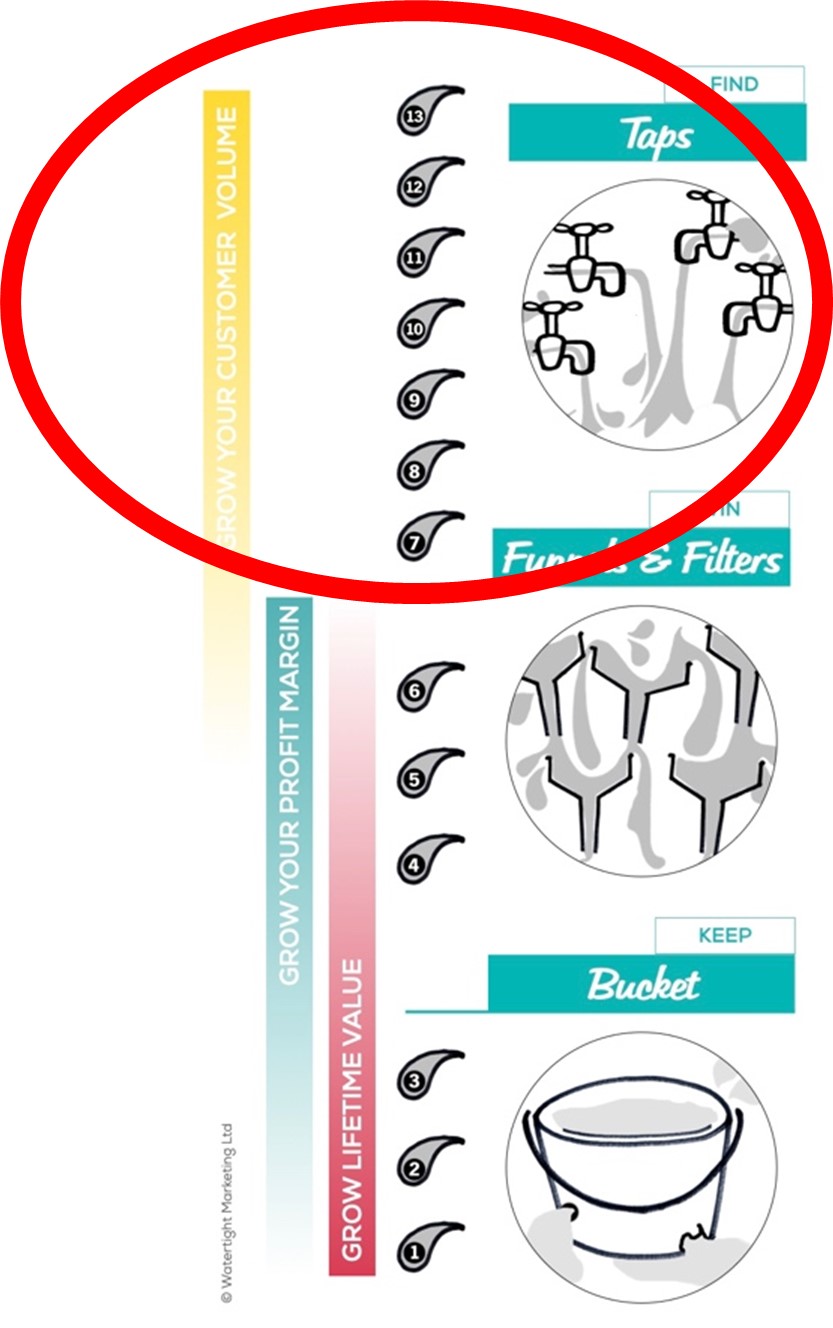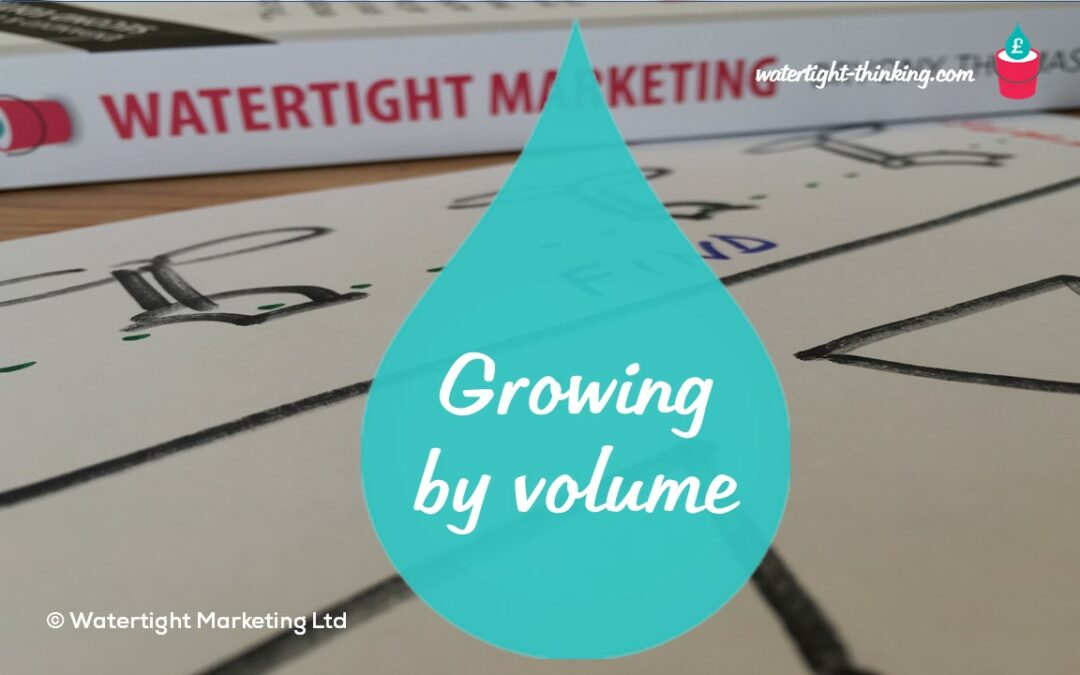Reading Time: 6 Minutes
In Bryony’s original blog ‘Growth: Do you want lifetime value, margin or volume?’, she explained the different types of growth a business can achieve through putting the right kind of marketing in place across the customer journey. She also explained how the Watertight Marketing methodology maps across that journey, and can be used to identify, prioritise, and address any gaps.
In this article, we take a deeper look at the ‘volume’ part of that concept, and how it relates to what many people think is marketing: generating leads ~ Cheryl Crichton | Watertight Business Thinking Master Practitioner and Co-Founder of the Make Marketing Happen Club
The Watertight Marketing methodology is a process of connecting your people with a common language to collaborate, and then use a series of frameworks and models to assess, sequence, and enact great marketing decisions.
When a business wants to grow, there’s a clarification process we take them through to work out which of our tools and frameworks will help them with that particular goal for growth (‘lifetime value’, ‘margin’, or ‘volume’).
Volume Growth: Widening your customer base
Let’s take another look at the diagram Bryony shared in her original blog.

Watertight splits a sales or decision journey into three phases, and within those we have identified thirteen Touchpoint Leaks™ . Deciding on the type of growth you’re after is one way of determining where in all this you need to focus.
In our terms, ‘volume growth’ requires marketing activity at the start, or top, of the customer journey – activity to generate leads and awareness. We refer to it as turning on marketing ‘Taps’, and it’s commonly what a lot of marketing suppliers are selling.
Marketing to grow volume of customers
If you need to turn on the Taps to generate more interested prospects, here are some ideas for fixing any of the seven leaks that sit within this section of your customer’s journey:
Leak 7 – Information Overload: Look at marketing that acts as Invitation Information, taking less than five minutes to consume, enjoy and point people to their next step. To fix this leak you could for example:
- Keep a note of any question you’re asked in your area of expertise that makes you think, makes you angry, or that you’ve heard more than three times.
- Create how-to guides on making a good buying decision for the types of things you sell, e.g., ten questions to ask a marketing consultant before working with them.
Leak 8 – How: Look at repurposing your content and materials into other formats so that people can access it in a way that suits their preferred style, device, and location. To fix this leak you could for example:
- Record your blogs as podcasts.
- Take a short course in using your smartphone to take great photos and quickly make them into content from your phone.
Leak 9 – Where: Look through your potential customers’ eyes and make a commitment to showing up in at least three places that you know they already look. To fix this leak you could for example:
- Where possible collect location data as you invite people to share information with you. This allows you to tell them about things in their area, or advertise based on postcodes, etc.
- Target your advertising based on demographic information, such as job roles, qualifications, gender, location, age, etc.
Leak 10 – When: Look at the times you release your materials, make yourself available, and map activity to when you know potential buyers are looking. To fix this leak you could for example:
- Create a baseline marketing activity plan in which you commit to the lowest level drumbeat of activity you can do consistently.
- Create content on a seasonal theme for release at the right moment e.g., ‘School holidays – the summer survival kit for solo entrepreneurs’, ‘Valentines – how to get finance to fall in love with marketing’.
Leak 11 – Who: Look at marketing that appeals to, or features, people of influence (even if that’s only in your field), and uses themes that mean that people are most likely to pass on to their own networks. To fix this leak you could for example:
- Look through the last few months or years of headlines in your key identified media titles to spot patterns in their articles and craft content for them.
- Set aside a day a couple of times a year to get your team to collate all the things that really get them agitated in your industry. Have a rant-fest and get the ideas down – choose a few that you’re happy to go public on.
Leak 12 – What: Look at how you describe what your business offers to ensure that it is clear and set in context, and consistently presented. To fix this leak you could for example:
- Create a signature process, system, or methodology for what you do. Give it a name with Leading Caps and consider trademarking it.
- Create a visual anchor that shows the range of things that you do, for example a grid, a ‘Trivial Pursuits’ style pie, a tourist map, a conceptual or process diagram, e.g. The Thirteen Touchpoint Leaks™
See also Va-Voom! Worked examples in the second edition of Watertight Marketing.
Leak 13 – No Emotional Impact: Look at ways to stand-out and trigger an emotional response in your materials so that people cannot help but notice it. To fix this leak you could for example:
- Use bright colours and bold design that stand out from the norm in your industry.
- Use words like ‘almost always works’, e.g., ‘10 marketing tips that almost always work’ is often more appealing (particularly to a cynic) than ‘10 totally guaranteed marketing tips’.
Make sure you lay down the next step
One thing we often see missing is the next step. It’s all very well plugging one or more of Leaks 7 to 13 to support volume growth, but without putting the next step in front of them, you’re not encouraging them towards buying from you.
This means two things.
Firstly, that you need to map the whole journey, not just plug the leaks and hope for good results. Secondly, consider what the right next step is for them. Some examples of what we mean are:
- A LinkedIn poll that links to a blog you’ve just written on a topic relevant to your audience.
- An offer that invites people to join you on a webinar.
- A 30-second tips video that leads to an e-book download.
- For everyone who downloads that e-book, and invitation to a related event.
- A message to people to see if they would be interested in receiving more information about your latest research report.
If your purchase is a considered one for your customers, you can’t short-cut this. People need time and don’t like to be rushed from the first time they see sight of you (and clock that you sell something they might need) to buying that thing from you. This necessarily means that it’s better to ensure you don’t have gaps in your Bucket (existing business and customers) or at the Funnels & Filters stage (warm prospects) before you look at gaps in your Taps. Otherwise you’ll spend time, money and energy plugging Taps leaks and customers still might not go any further because of gaps further along their journey.
Run the numbers
Make sure you know the numbers. To get one new client, work out how many warm conversations you need at the Funnels & Filters stage. To get one warm conversation, determine how many interested prospects you need to read your blog, download your valuable content or come to your masterclass. This will give you some indication of the volumes you need and the ratio of each you need to go to the next step. It also gives you a benchmark – if you’re not getting the volumes or ratios you need, the marketing isn’t effective for some reason and needs to be tweaked.
We have hundreds of ideas and real-life examples of how businesses have identified and fixed leaks using the Watertight Marketing toolkit. Maybe have a think about whether your marketing supports a healthy sales flow. There’s plenty more advice and ideas in Chapter 8 of the second edition of the Watertight Marketing book, so do dive in.

Cheryl Crichton
Watertight Marketing Master Practitioner
Cheryl is an award-winning marketing coach and advisor and one of our Master Practitioners. She loves a bit of strategy, but is never happier than when she’s elbow deep in delivering a serious bit of clever marketing. Covering digital, social media, direct marketing, events, website build, brand, advertising.


